|
I drew this bridge in 2000, using plans from the book 'Marquette' by Cecil Cook, which has Ted Schnepf's Milwaukee Road plans. I also used the 'Bridge and Trestle Handbook' by Paul Mallery.
It seems I am out-living some web servers. Now it is 2019.
Here are Links to other historical web pages about this bridge (which was abandonned in 1961)
CMStPandP Mississippi River Crossing At Reeds Landing posted in 2011 by John Weeks, the web page still up in 2019
The Milwaukee Roads Floating Pontoon Railroad Bridge Across the Mighty Mississippi River, The Chippewa Valley Line by Travis Dewtiz 2015, with a 1915 picture of Reeds landing, Iowa University, Marquette bridge has a short story, 2 pictures, and some old newspaper history Chamberlain South Dakota bridge that replaced a pontoon As of 2019, just one picture was on Bridgehunter Reads Landing
Railway Preservation forum for Museum at the McGregor depot in 2015 has pictures.
Trains magazine article about Praire du Chien https://www.mrha.com/view-article-index.aspx is an index of many bulletins https://industrialscenery.blogspot.com/2019/09/dakota-southernmilwaukee-rr-bridge-over.html shows South Dakota bridge history very well https://commons.wikimedia.org/wiki/Category:Chicago,_Milwaukee,_St._Paul_and_Pacific_Railroad has links and pictures http://wikimapia.org/10137080/Former-Milwaukee-Road-Roundhouse seems to want to work with just Chrome? https://en.wikipedia.org/wiki/Pile Pontoon_Railroad_Bridge is about Marquette https://wisconsinhistory.org/Records/Image/IM24811 one picture, might be the east pontoon on scows?
My intention with my web page is to let it be known that I have these scale plans,
Or, like I did, I printed it and glued the paper to some blocks of wood to simulate the bridge until I might build it of wood sticks. |
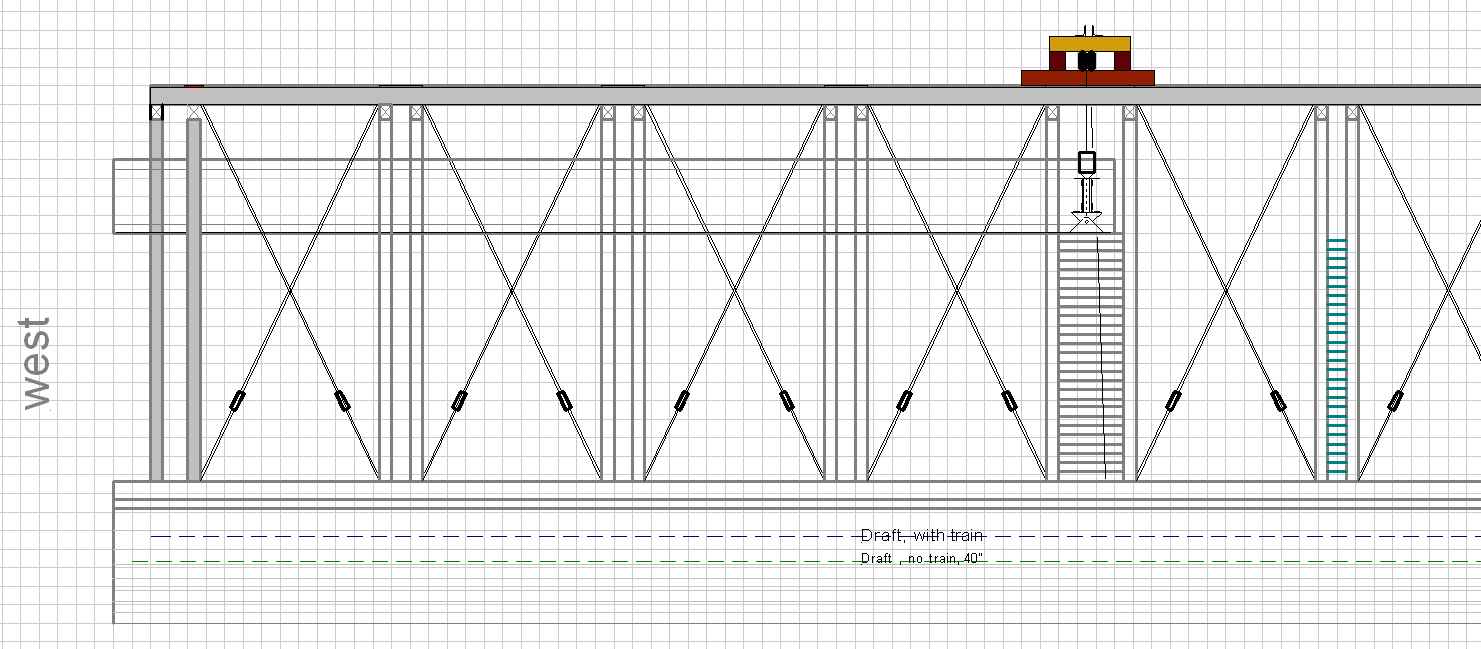
|
The pontoon bridges consisted of 3 parts; the barge scows that floated in the water, an approach girder bridge that allowed some height adjustment between the fixed approach trestles and the floating barge, and short 20 foot brige spans on wood blocks between each timber tower for the majority of the bridge.
Below is a 40 foot long steel girder that is an apron spanning from the fixed trestle near the end of the pontoon,
I don't make my girder moveable for height like the real thing. The real pontoon floats, and when the weight of a train moves onto the pontoon, it pushes the pontoon down over a foot. The yellow things on my picture below are blocks of wood that hold up the girders and track, and transfer the train weight onto the floating pontoon. The color picture below has gray shaded areas, which is just open air space. The timber rectangle frame has diagonal stiffening cables and turnbuckles. On some old pictures, you can look all the way through the timber works, it has an open 'airy' look to it. Some of the earlier designs and other locations had extra angle sway braces toward the up- and down- river sides, and that would also be interesting to model. The Milwaukee Road had two pontoons between Marquette and Prairie du Chien, one for the west channel and one for the east channel. The Missourri River in South Dakota had one pontoon. Read's landing near Wabasha, Minnesota, had one pontoon. And there were different designs over the years, such as the barge scow at water level at PDC east, where the approach tracks just followed the slope of the river bank and crossed the barge. If the river rose, the approach tracks had to be lifted or blocked up. With the final design of the bridge, the approach tracks were built on trestles and bridges at a fixed height to be above the highest water lever expected, and the pontoon was allowed to float and the bridge spans on the pontoon were adjusted to match. It's easier to adjust the level of 270 feet of track on the pontoon than a quarter mile on the approach tracks. |
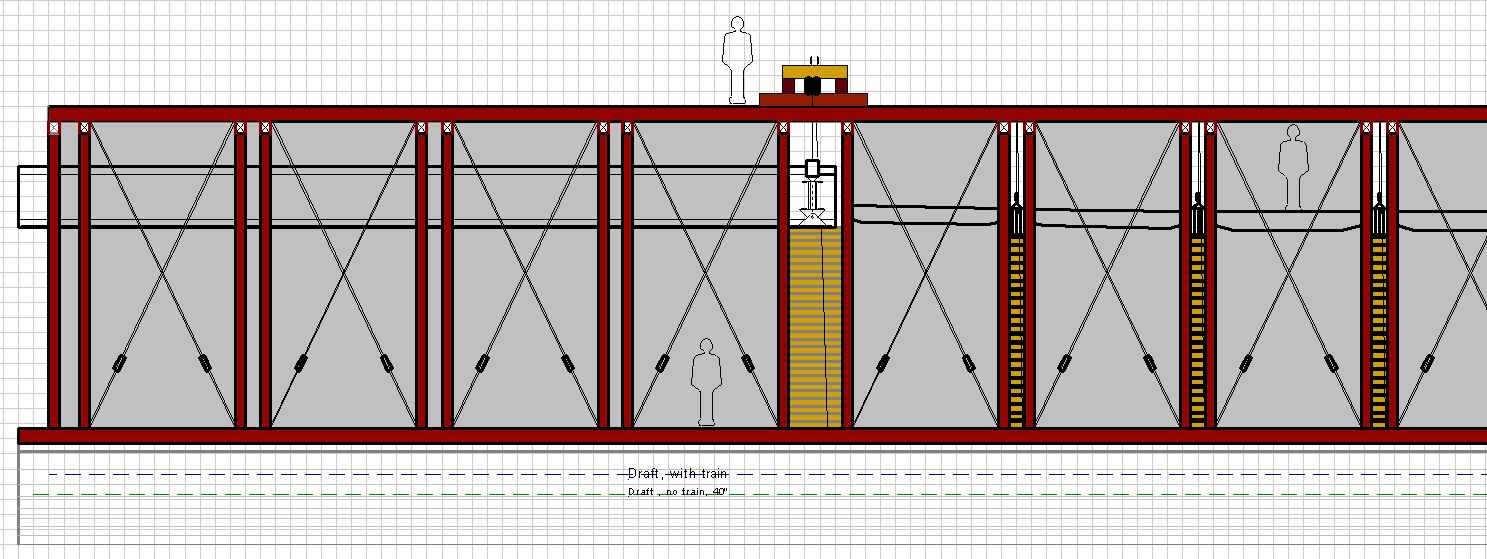
|
Anyway, I didn't intend to give an in-depth discussion of a railroad pontoon bridge with this web page. I just wanted to let it be known that I have some scale drawings to share. Below is a picture of the final version at the Marquette west channel, it's 275 scale feet. If you print it so the bridge is 38 inches long, you would have an HO scale plan. You could make a higher quality print by using a drafting program with my file, that I can email to you.
|

|
My model only got as far as a paper wrapper for some blocks of wood to symbolize the bridge. Remember, the gray color between the timbers is open air space, but not on this model. Some year, I might actually build it of wood sticks and cardboard joiner plates. My intent to is mount this bridge on a Dutch door, that would simulate how it pivots and swings in the river, and allow me access into the layout and get tracks across a doorway.
My model is crude, I didn't model the entire depth of the wood plank barge scows that extend 4 feet below the water line. |
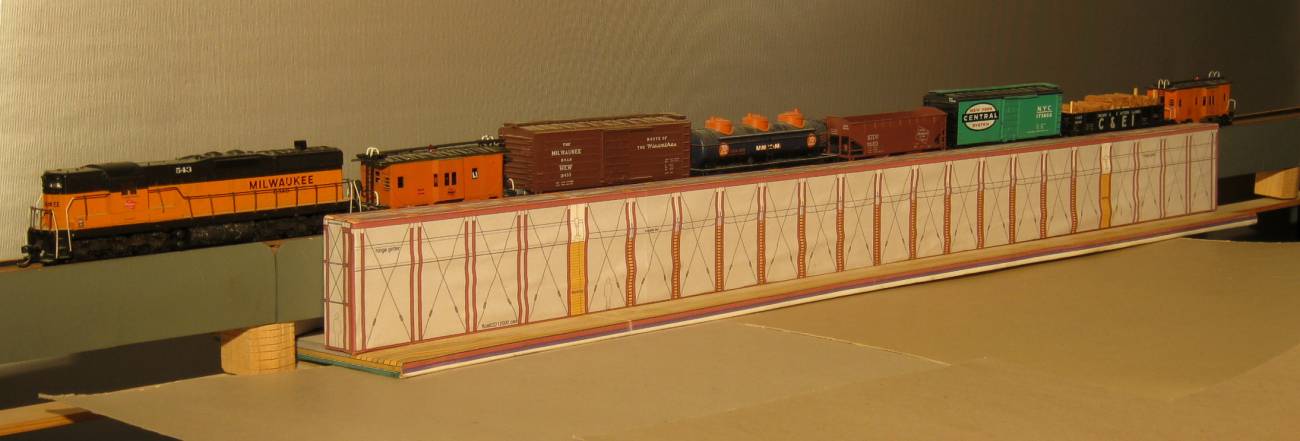
|
The pontoon aprons and spans are set according to river level. The water could go up and down over 20 feet with the seasons. Wood blocks were added or removed, to keep the track somewhat level with the fixed height of the trestles and bridges that lead up to the pontoon. (But on my model, I simplify that greatly and keep my tracks perfectly straight and level for dependability.)
The picture on the left shows a float setting for low water, the right is for medium- high water. |
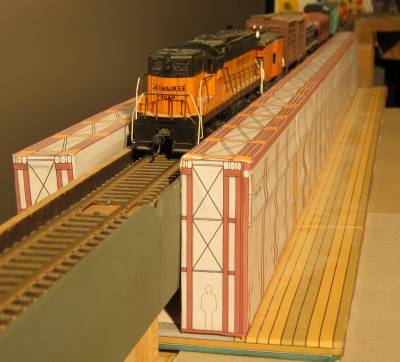
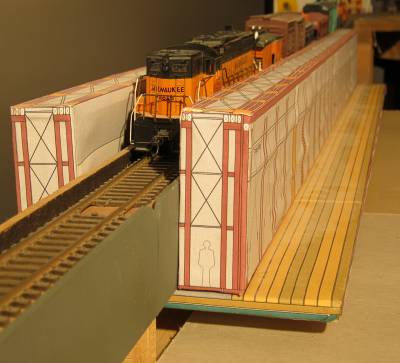
|
I got my best information about the bridge from a book. I drove to the Prairie du Chien library in (? 1978 ?) and asked if there might be some historical information about this bridge. The Librarian said she knew exactly who to call, and she phoned a local retired historian and he came over and got in my car and we drove across the Mississippi River to Marquette to a little general store, where a nice little old lady had 2 copies of the book and some postcards.
The post card (25 cents) and book ($9.95)
|
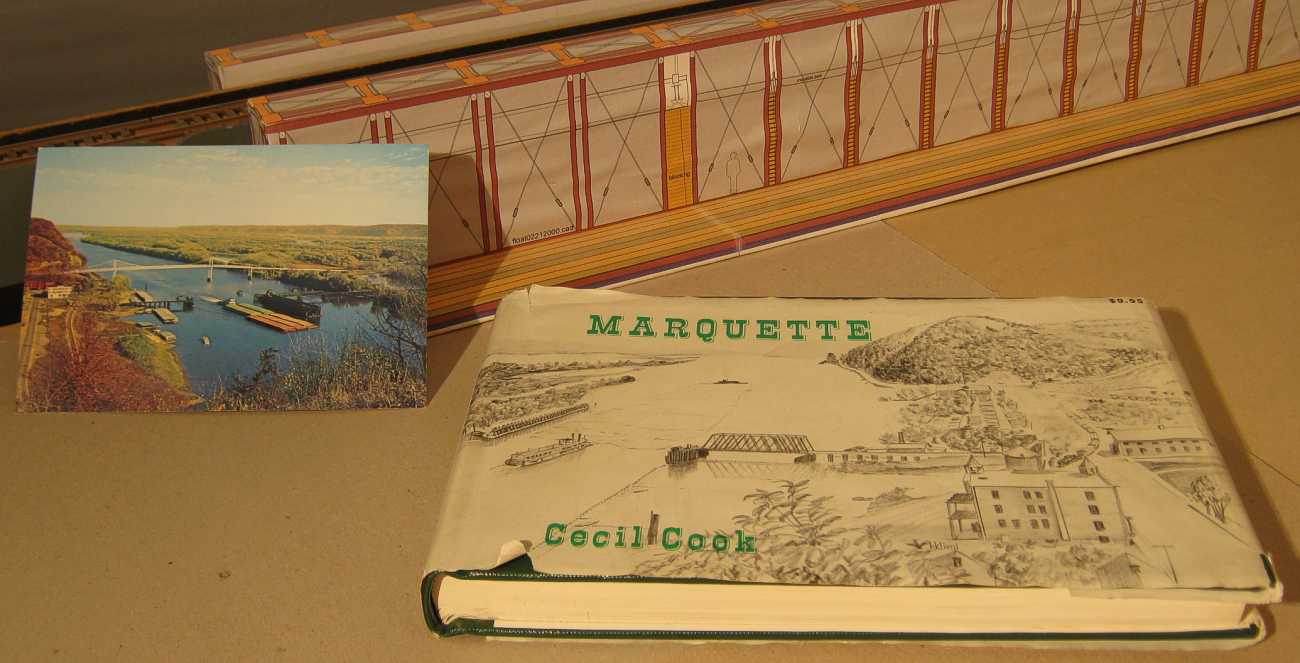
|
In about ? 1992 ?, I was in the Wabasha (Minnesota) Historical Society brick building, where they had some pictures of the Read's Landing pontoon bridge. And I heard that some gentleman near there might have built a scale model of that. But I haven't been back to there in years to learn if that was so, and if the model exists anymore.
|
Most of this page was filmed and wrote about in November, 2019.